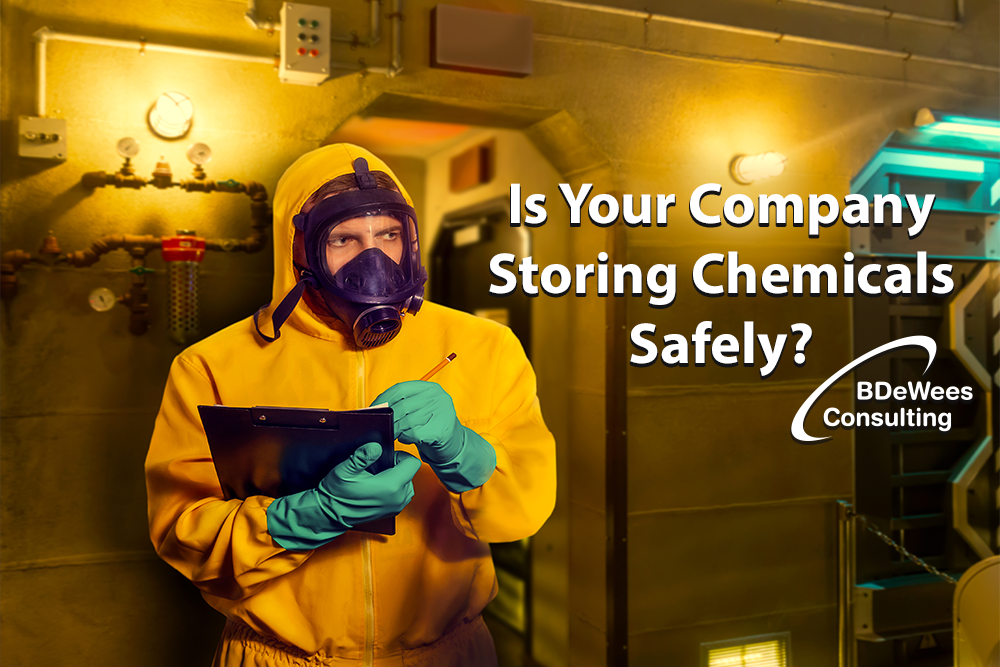Is Your Company Storing Chemicals Safely?

Safe chemical handling requires routine inspections of chemical storage areas and consistent maintenance of your inventory. Even when hazardous materials are out of sight in containers, they should never be out of mind. Here are six ways to help keep your work environment safe when storing hazardous chemicals.
Have a plan in place. OSHA’s Occupational Exposure to Hazardous Chemicals in Laboratories standard requires a Chemical Hygiene Plan (CHP) to protect laboratory workers from harm due to hazardous chemicals. Make sure that your company is following all regulations and provide specific procedures for your employees to follow.
Some of the physical hazards that can occur include:
- Fire
- Explosion
- Sudden release of pressure (for instance, if a tank of compressed gas is punctured)
- Reactivity (fire, explosion, or release of dangerous gases that can result from contact between particular chemicals and certain other chemicals or air or water)
Training needs to be a priority. The less training you provide the more likely an accident will occur. Workers need to be properly educated to protect themselves and the workplace while being able to address any emergencies. Make sure that the proper storage documentation is easily and readily accessible for workers at all times. Accidents happen, so it’s important that they are educated and trained for spill-response drills.
- The location of the chemical hygiene plan
- The location of SDS and other educational literature
- How personal protective equipment is selected, its location, how to use each piece properly, and how to determine when it needs to be replaced
- The hazards presented by each chemical and procedure in the laboratory
- How to handle chemicals properly to avoid exposure
- How to label containers correctly
- Proper laboratory hygiene and conduct, such as never eating, drinking, or chewing gum in a laboratory; confining loose hair and clothing; and avoiding horseplay and practical jokes
- How to use the “buddy system” to avoid working alone
- How to evaluate the procedure or process they’ll be performing so that they take only the amount of chemicals necessary for the job they’re doing
- How to handle waste materials
Ensure that all chemicals are properly labeled. It’s important to keep your products labeled with the correct hazard warning to avoid a disastrous encounter. Remind your workers that if labels start to wear and tear, it needs to be taken care of immediately. The chemicals are to contain the appropriate GHS information. Always check expiration dates.
Always inspect the work area and keep it clean. Your employees need to be able to move around the area without any interference or unnecessary obstacles to avoid dangerous falls and spills. Make it a priority to inspect and clear the area before handling and storing any chemicals.
Look for unusual conditions in chemical storage areas before working, such as:
- Improper storage of chemicals
- Leaking or deteriorating containers
- Spilled chemicals
- Temperature extremes (too hot or cold in storage area)
- Lack of or low lighting levels
- Blocked exits or aisles
- Doors blocked open, lack of security
- Trash accumulation
- Open lights or matches
- Fire equipment blocked, broken or missing
- Lack of information or warning signs (“Flammable liquids”, “Acids”, “Corrosives”, “Poisons”, etc.)
Make sure the right tools are available. Storage tools such as the correct containers are extremely important to have. If these aren’t readily accessible when needed, workers may use what is available to them, causing chemicals to be stored incorrectly. Along with the proper storage equipment, emergency and safety tools need to be available as well; such as fire extinguishers, spill clean-up materials, protective clothing, etc. OSHA specifies the equipment that should be provided and requires that it meet the quality standards established by the American National Standards Institute (ANSI)
Provide adequate Ventilation and Drainage. Ventilation is important to have when handling strong odor chemicals. Verify that the heating, ventilation and air conditioning (HVAC) systems in place are operating effectively and adequate for the space. Proper drainage is important to prevent chemical spills from spreading into the water supply.
Hazardous chemicals are extremely dangerous when not stored properly. Always make sure your staff is well trained, ensure the right tools are available and the work environment is set up properly. Find out more about our Safety Consulting here and contact us today!
Jim DePew
Vice President & Consultant
Mobile: (330) 631-9022
Office: (330) 915-2355 Ext: 103
Email: jdepew@bdewees.com
